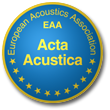| Issue | Acta Acustica Volume 97, Issue Number 4, 2011 |
|
|---|---|---|
| Number of page(s) | 9 | |
| DOI | https://doi.org/10.3813/AAA.918446 | |
Experimental and Theoretical Investigations of Phonation Threshold Pressure as a Function of Vocal Fold Elongation
- Chao Tao
- Michael F. Regner
- Yu Zhang
- Jack J. Jiang
Abstract
The relationship between the vocal fold elongation and the phonation threshold pressure (PTP) was experimentally and theoretically investigated. The PTP values of seventeen excised canine larynges with 0% to 15% bilateral vocal fold elongations in 5% elongation steps were measured using
an excised larynx phonation system. It was found that twelve larynges exhibited a monotonic relationship between PTP and elongation; in these larynges, the 0% elongation condition had the lowest PTP. Five larynges exhibited a PTP minimum at 5% elongation. To provide a theoretical explanation
of these phenomena, a two-mass model was modified to simulate vibration of the elongated vocal folds. Two pairs of longitudinal springs were used to represent the longitudinal elastin in the vocal folds. This model showed that when the vocal folds were elongated, the increased longitudinal
tension would increase the PTP value and the increased vocal fold length would decrease the PTP value. The antagonistic effects contributed by these two factors were found to be able to cause either a monotonic or a non-monotonic relationship between PTP and elongation, which were consistent
with experimental observations. Because PTP describes the ease of phonation, this study suggests that there may exist a nonzero optimal vocal fold elongation for the greatest ease for phonation in some larynges.

